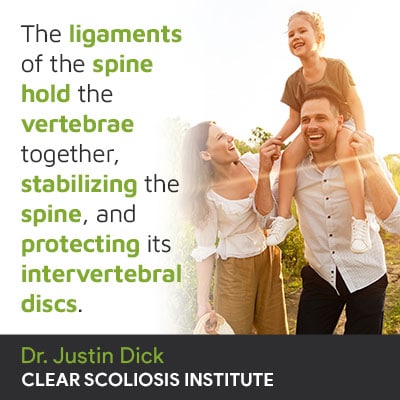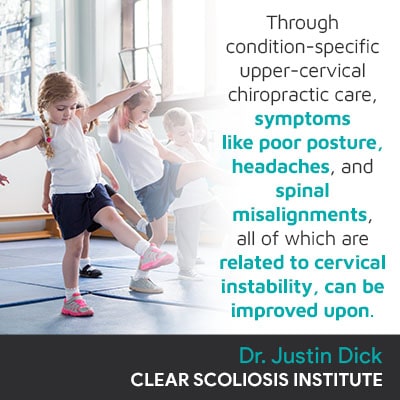
Also known as cervical spine instability, cervical instability can produce a range of symptoms involving the muscles and nerves surrounding the cervical spine, as well as the structure of the cervical spine itself. From headaches to muscle pain, cervical instability is caused by lax ligaments.
Cervical instability occurs when ligaments in the neck are excessively loose, causing an unnatural range of motion in the area and affecting the structure of the cervical spine itself. The condition has different causes, and symptoms/treatment needs are case-specific.
Before getting to the specifics of cervical instability, let’s first touch on some basic spinal anatomy, for a better understanding of the spine’s overall health and function.
The spine has three main sections: cervical (neck), thoracic (middle/upper back), and lumbar (lower back). If a healthy spine is viewed from the sides, it will have a soft ‘S’ shape, and if viewed from the front and/or back, it will appear straight; this is due to the spine’s natural spinal curves that make it stronger, more flexible, and better able to absorb/distribute mechanical stress. Each of the spinal sections has its own natural curvature type (either bending inwards towards the body’s center, or outwards, away from it), range of curvature degree, and range of motion (ROM).
If a person’s curvature degree and range of motion falls within a normal range, this helps the spine function optimally; if a person’s spinal curve becomes under- or over-exaggerated, range of motion can be affected by the spine’s misalignment.
If the cervical spine’s range of motion is affected, the biomechanics of the entire spine can be disrupted as the integrity of each spinal section and its curves are based on the health of the others.
The spine is made up of bones called vertebrae, and they are stacked on top of one another in a straight and neutral alignment, thus preserving the spine’s natural curves.
The vertebrae are separated by intervertebral discs, and these discs give the spine structure, facilitate flexible movement, provide cushioning between adjacent vertebrae, and act as the spine’s shock absorbers.
The ligaments of the spine also play an important role in maintaining optimal spinal health and function.
Ligaments are fibrous bands of connective tissue that attach bone to bone, holding structures together and keeping them stable.

The three main spinal ligaments are the ligamentum flavum, anterior longitudinal ligament (ALL), and the posterior longitudinal ligament (PLL); these ligaments protect the bones of the spine by preventing excessive movement of the vertebral bodies.
What is Cervical Instability?
When the ligaments of the cervical spine become excessively loose, lax, and/or stretched, the vertebrae in the neck are not adequately stabilized and an abnormal range of motion can develop as a result; this strains the neck and its surrounding muscles that struggle to support an unstable section of the spine.
While all spinal sections are important and have their roles to play in preserving the health of the spine, the cervical spine has the added task of supporting the weight of the head, and facilitating the neck’s range of motion.
Posture is also important for the cervical spine because in supporting the weight of the head, if the head shifts forward as little as one inch, the weight of the head, on the cervical spine, increases by 10 pounds.
Known as forward head posture, aka tech neck, forward shifts in posture can add up to 30 pounds of abnormal leverage on the cervical spine.
Over time, forward head posture can cause long-term muscle and ligament strain, disc herniation, and/or pinched nerves.
When the ligaments in between the spinal cord and skull become loose, they can facilitate excessive movement of the top two cervical vertebrae at the base of the skull, and this cervical instability can cause a variety of symptoms.
Cervical Instability Symptoms and Common Causes
When it comes to cervical instability symptoms, they can vary from one patient to the next based on a variety of factors such as severity and underlying cause.
Some common causes of cervical instability include spinal conditions such as cervical spondylosis (age-related spinal degeneration that affects intervertebral disc health), overuse injuries, trauma such as whiplash (commonly sustained in car accidents), genetic conditions like Down syndrome, and connective tissue disorders such as rheumatoid arthritis.
Remember, as the spine works in tandem with the brain to form the body’s central nervous system (CNS), spinal conditions can also affect spinal nerves that facilitate brain-body communication and have extensive pathways throughout the body; thus cervical instability can produce a long list of both physical and neurological symptoms.
Some common symptoms of ligament laxity in the neck can include:
Now that we have addressed some common symptoms of cervical spine instability, let’s talk about how it’s diagnosed.
How is Cervical Instability Diagnosed?
In order for cervical instability to be diagnosed, a physical exam combined with magnetic resonance imaging (MRI) scans, computerized tomography (CT) scans, and/or digital X-ray imaging, can help us see what’s happening in and around the spine: identifying any areas of spinal subluxation.
MRIs can be performed with patients in different positions, such as laying flat on the back or sitting/standing upright, as can X-rays.
If it’s determined that the structure/curvature of the cervical spine has been impacted by lax ligaments in the neck, supported by key measurements, a diagnosis of cervical instability, also known as cervical spine instability, may be made.
So what are the treatment options for cervical instability?
How to Fix Cervical Instability
There are different treatment options for cervical instability, and as a CLEAR-certified scoliosis chiropractor, I rely on a conservative chiropractic-centered treatment approach to deliver the best long-term results.
By customizing each and every treatment plan to address important patient/condition characteristics such as patient age, condition and symptom severity, and underlying cause, improvements can be made to the health and function of the cervical spine, positively impacting each of the spinal sections below.

In fact, studies have shown that spinal manipulation therapy is an effective treatment for correcting cervical instability, a variety of joint disorders, cervical-vertebrae dislocations, and more.
Gentle and precise chiropractic adjustments of the cervical spine involve manipulating the position of affected vertebrae so the neck’s natural curve and alignment can be restored; this reduces uneven forces exposed to the spine and its surrounding muscles, ligaments, and nerves.
Condition-specific physical therapy can also be an effective means of strengthening the neck and restoring its normal range of motion, and is most effective when integrated into a proactive treatment plan that includes chiropractic care.
A variety of condition-specific exercises/stretches, when performed as prescribed, can help with strengthening the cervical spine and its surrounding muscles, postural remodeling, improved joint mobilization, soft-tissue mobilization, and spinal manipulation.
When the cervical spine and its surrounding muscles are kept as flexible and strong as possible, this means the vertebrae are receiving optimal support and stabilization; in addition, a cervical spine that can maintain its natural curve and alignment is one that is better able to support the weight of the neck and head, withstand injury, and maintain a healthy range of motion.
From spinal conditions like spondylosis to common spinal traumas such as whiplash, cervical instability has a variety of underlying causes.
Once the ligaments of the cervical spine become loose, affecting the way the bones of the spine stay together and mobilize, an unnatural range of motion of the cervical spine may occur, along with a number of additional symptoms. While there are no guarantees, effective treatment involves customized treatment plans crafted around the condition’s underlying cause.
By combining a variety of condition-specific chiropractic techniques and physical therapy exercises, the position of affected cervical vertebrae can be gently adjusted, improving the neck’s overall posture and ability to support the weight of the head; strengthening exercises can help the muscles surrounding the cervical spine stay strong so they can optimally support/stabilize the neck, taking pressure off related ligaments.
As the cervical spine has to support the weight of the head while connecting the brain to the rest of the body, its health is important not only in terms of preserving overall spinal health and function, but also because of its involvement in brain-body communication.
From headaches and dizziness to muscle pain and limb weakness, conditions affecting the cervical spine can produce a myriad of symptoms felt throughout the body and related to the degree of nerve involvement.
As a CLEAR-certified scoliosis chiropractor, I follow the CLEAR Scoliosis Institute treatment protocols that value the merits of proactive treatment delivered under a conservative chiropractic-centered approach.

CLEAR provides a unique and innovative way of understanding scoliosis. Sign up to receive facts and information you won’t find anywhere else.

I had a neck massage where they were rotating my neck and pushing on trigger points. After the massage I noticed ear fullness then 2 days later loud tinnitus. I have no pain and I would like to know if they could have caused my ear fullness. Could I have cervical instability and don't even know it? If so what should I do to get it diagnosed?
Hello, Steve,
Those are all great questions. Nerves exiting your neck area control ears, nose and throat. It is possible that a massage could have caused some detoxing and draining in those areas or, if there is a backup, could have caused "fullness". Most likely the fluid and ringing have an underlying reason for being there and the massage could have aggravated it. Also, it could be something else entirely and it was just a coincidence that you also had a massage around the same time. Someone can have cervical instability without knowing. Actually, it is more likely to not know you have cervical instability than to know without diagnosis. You would need to consult either your primary care physician or a chiropractor who specializes in cervical instability to diagnose or determine this. Our CLEAR Scoliosis Institute certified Doctors have specialized training as well as specialized equipment in their offices to treat cervical instability. If you would like to reach out to one of them, please visit our website under Find a Doctor to find the doctor closest to your area. Best of luck.
good morning
it has been years of research and your article make sense to me. my neck is so instable and heavy i feel the ligaments loose. (im leaving a nightmare everyday) and i feel my lower jaw so heavy. i told my doctor i think is due to the jaw i had mri of the jaw and cervical, the only finding is the c6c7 are unstable. do you think it is due to the jaw or neck, and do you know a doctor or specialist who will be able to pinpoint the problem.
i live in georgia alpharetta.
thank you
Ines
Hello, Ines,
Thank you for reaching out. When you have instability of the neck, it can be painful and worrisome. The same nerves that exit from your neck supply the function and muscles of the jaw. If the ligaments are unstable, there is oftentimes a loss of the normal cervical curvature. If that is the case, our CLEAR Scoliosis Institute certified Doctors have specialized equipment in their offices that help to restore the natural curvature of your neck. I would suggest contacting the clinic nearest you to determine if that is the source of your issue and if their assistance would help alleviate your problems. The clinic nearest you is Dr. John Gatell in John's Creek, 678-403-2121. Best of luck to you. Please let us know if we can be of further assistance.